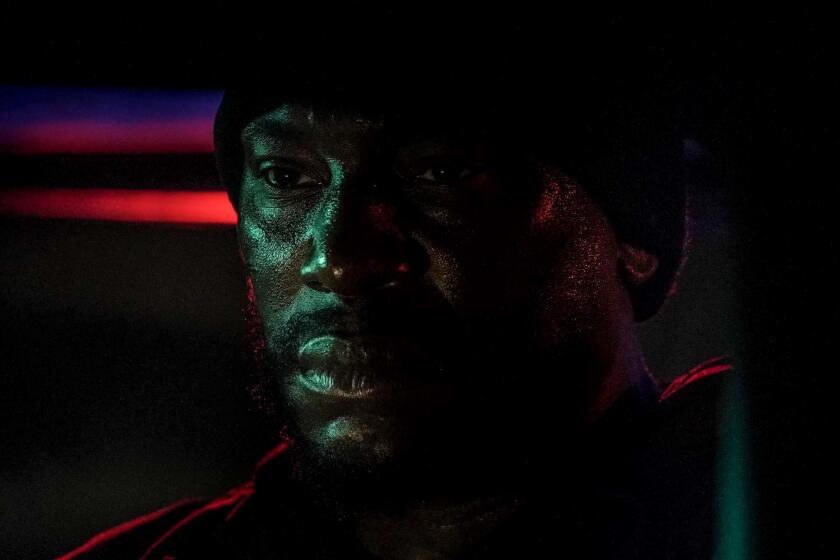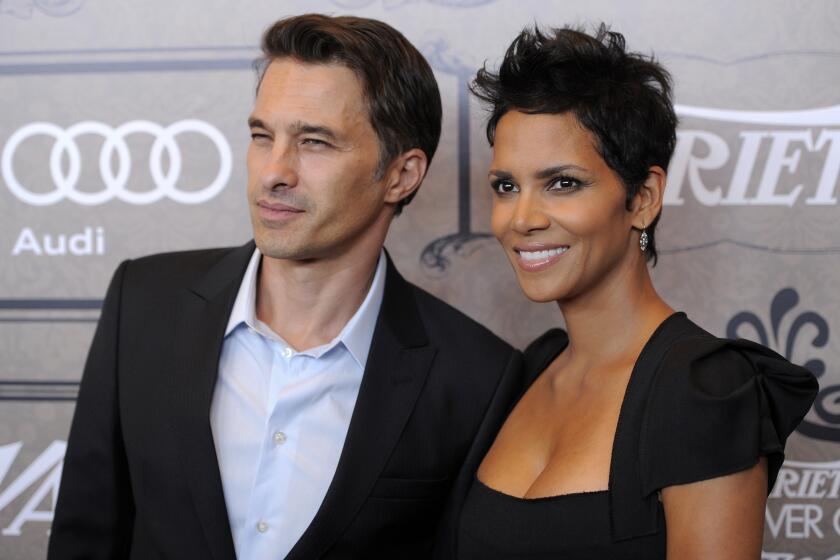‘Inside Out,’ ‘The Matrix’ and more: Ranking cinema’s notable head trips
Whether you’re talking about a film or a relationship, it’s never easy getting inside someone’s head.
Sure, directors have tried many tactics to achieve the former (hello, cheesy voice-over). But actually making private thoughts and musings coherent on-screen is never a simple task. It’s even doubly difficult if a movie looks to create tension and meaningful narrative there.
Yet over the years screenwriters have been drawn again and again to stories set right in the noggin, in genres that include science fiction (“Inception,” “The Matrix”) and action-adventure (“Fantastic Voyage”). They try again this weekend, this time in the realm of the animated family dramedy (the new Pixar release “Inside Out”).
All of these entertainments offer the promise of action unfolding inside an unknowable mystery, while also presenting some unique challenges. How does one render visual what is so abstract? And how does a story move from action that is, quite literally, interior to the more navigable outside world?
We’ve collected seven notable mental movies and rated them on a scale of 1-10, from the ones that handle the challenges sharply to those that are, well, just noodling. (Actually they’re listed in ascending order of quality--it’s fun to mess with heads). Read and quibble, or just let the mind wander.
7. “Fantastic Voyage”
Director Richard Fleischer’s Cold War thriller gets inside the head of one of its characters — quite literally — by way of a microscopic submarine. The film concerns a Czech scientist who has defected to the U.S. but fallen into a coma after an assassination attempt. To save him, and the knowledge only he has, a crack medical team is zapped with a shrink ray and injected into his bloodstream so they can surgically remove a clot in his brain.
Though the film doesn’t feature any personified emotions or manifestations of dreams, it does offer a psychedelic tour of the human body with unexpected doses of danger — watch out for those white blood cells! As the movie’s trailer promised, “When you come out, you may never look at yourself in the same way again.”
Ultimately though, “Fantastic Voyage” is as much a biological adventure as a mind-bending one. So though a great movie, it’s not a great head-trip movie.
Brain Power Index: 3
6. “The Matrix”
Mind over matter is most certainly the rule in the Wachowski siblings’ stylish dystopia. Although neither protagonist Neo (Keanu Reeves) nor the audience realizes it for some time, most of the action — from the slow-motion fistfights to the clip-emptying shootouts — takes place in a massive shared hallucination. That doesn’t make the battles any less lethal, as wise old Morpheus (Laurence Fishburne) warns. “Your mind makes it real.”
The film’s premise of a machine-programmed world allows the brain-bending antics to range far and wide. And visual cues like sleek black clothes and a sickly green tint differentiate the Matrix from the real world (all cold, post-apocalyptic blues).
Still, the film’s sprawling alternate universe always seemed like it could, and maybe should, be taking placing somewhere else beside a mind; that’s a lot of imagination and I.Q. required for someone, even or especially someone who’s Keanu Reeves. And the passage from the mental to the physical realm can be a little bumpy — it’s mainly depicted by Neo and friends reclining in chairs that have a distinct dentist-office vibe.
Brain Power Index: 4
5. “Inception”
In Christopher Nolan’s mental heist movie, it’s not cash, diamonds or priceless paintings that are stolen, but ideas. Dom Cobb (Leonardo DiCaprio) and his crew specialize in surreptitiously entering people’s dreams in order to lift — or more dangerously, implant — information.
We all know how surreal dreams can be, with paradoxical shifts in time and location, and writer-director Nolan delights in rendering such visual riddles on the big screen. He even compounds the weirdness by creating dreams within dreams within dreams, thus layering a car chase with a zero-gravity brawl with a snowy black-ops mission.
And yet, as visually impressive and meticulously designed as “Inception” is, it occasionally gets bogged down by exposition, arbitrary rules and plot inconsistencies. As with any dream, trying to wrap your head around the movie can be an exercise in futility. Movies should be about getting outside our own heads, but that doesn’t always mean we want to get inside someone else’s.
Brain Power Index: 6
4. “Eternal Sunshine of the Spotless Mind”
Yes, an ethereal Kate Winslet on the beach will make us choke up each time. But it’s the scenes inside its lovelorn hero’s head that give the movie its power.
“Eternal Sunshine,” directed by Michel Gondry and written by Charlie Kaufman (he liked setting stories in the mind--more on him in a second), looks at Joel (Jim Carrey) as he seeks to erase a relationship from his brain as a way of getting over a breakup with Winslet’s Clementine--and then tries in vain to salt away some of those memories in his subconscious. The film has a head-trippy power, examining what happens when we become unsure of whether we want to retain our own memories.
Sure, sometimes “Eternal Sunshine” can become a little too caught up in its own conceptual ambition, and it can be a little jarring to go from the deep subconscious to Elijah Wood and Mark Ruffalo sitting around a bedroom. But there’s a strong sense of playfulness -- see under: the scene with a manchild Joel under the kitchen table. And with its bottomless wells of emotions, “Eternal Sunshine” does what so few films of this subgenre do: take us from the head to the heart.
Brain Power Index: 8
3. “Inside Out”
Peter Docter’s Pixar film that got, well, our heads thinking about this reaches for a high level of ambition, and for the most part it succeeds. Yes, the idea of a set of anthropomorphized emotions governing us isn’t high-level Jungian theory, and might make for some confused parent-child discussions on the way out of the theater.
But the range of those emotions is wide, with the characters of Joy, Sadness and the others are all sharply drawn. The world they inhabit is also filled with great detail and conceptual gags (“Train of Thought,” e.g.) And the movie handles, with a few exceptions, the transition from headspace to real space rather well, as it evolves from the quick cutbacks earlier in the film to the longer takes inside the mental universe as the movie wears on. A worthy animated entry to the subgenre that, in retrospect, almost seems tailor-made for manufactured creations instead of human actors.
Brain Power Index: 8.5
2. “Herman’s Head”
Granted, this was a TV show, not a movie, but it is a spiritual precursor to “Inside Out.” Instead of an adolescent girl, the early-’90s Fox sitcom chronicled the misadventures of magazine fact checker Herman Brooks (William Ragsdale). And while he was hardly the most developed character, the four avatars of his psyche were always interesting: his sensitivity (Molly Hagan), lust (Ken Hudson Campbell), anxiety (Rick Lawless) and intellect (Peter Mackenzie).
The side trips into Herman’s head were sometimes subtle (accomplished with straight cuts) and sometimes not (exaggerated with cheesy zooms or iris effects). But the idea that a quarter-century ago any screen entertainment would even try to take us inside someone’s head like this--and in broadcast prime time, no less--earns it extra points for originality. Peter Docter hasn’t copped to watching it yet. But it had to have been rattling around in the back of his, well, you know.
Brain Power Index: 9
1. “Being John Malkovich”
There’s weird, there’s good, and then there’s weirdly good. “Being John Malkovich,” the film that kickstarted the Hollywood careers of Charlie Kaufman and director Spike Jonze is, naturally, about a portal hidden behind a filing cabinet that leads into the mind and body of the titular actor.
The film’s out-there concept provides for an intriguing degree of self-exploration as different characters each take a spin inside Malkovich, confronting issues of ego, identity, gender, sexuality and mortality along the way.
The transitions into and out of Malkovich’s head are amusingly literal, and the actor’s point-of-view is rendered with some old-fashioned vignettes. A particularly memorable scene results from Malkovich entering the portal himself, with a hall-of-mirrors-like result. Needless to say, the whole thing makes you want to enter Malkovich’s mind, and Kaufman’s.
Brain Power Index: 10
Follow @ZeitchikLAT and @ogettell on Twitter
More to Read
Only good movies
Get the Indie Focus newsletter, Mark Olsen's weekly guide to the world of cinema.
You may occasionally receive promotional content from the Los Angeles Times.











